How to Read Regression Data in Excel
The tutorial explains the nuts of regression analysis and shows a few different ways to do linear regression in Excel.
Imagine this: you are provided with a whole lot of different information and are asked to predict next year's sales numbers for your company. You have discovered dozens, perchance even hundreds, of factors that tin can possibly affect the numbers. But how exercise yous know which ones are really important? Run regression analysis in Excel. It volition requite you an answer to this and many more questions: Which factors matter and which can be ignored? How closely are these factors related to each other? And how sure can y'all exist about the predictions?
Regression analysis in Excel - the basics
In statistical modeling, regression assay is used to guess the relationships between 2 or more variables:
Dependent variable (aka criterion variable) is the main factor you lot are trying to understand and predict.
Independent variables (aka explanatory variables, or predictors) are the factors that might influence the dependent variable.
Regression analysis helps yous sympathize how the dependent variable changes when one of the independent variables varies and allows to mathematically determine which of those variables actually has an touch on.
Technically, a regression analysis model is based on the sum of squares, which is a mathematical style to detect the dispersion of data points. The goal of a model is to get the smallest possible sum of squares and draw a line that comes closest to the data.
In statistics, they differentiate between a simple and multiple linear regression. Simple linear regression models the human relationship between a dependent variable and i independent variables using a linear function. If you use two or more explanatory variables to predict the dependent variable, y'all deal with multiple linear regression. If the dependent variable is modeled as a non-linear function considering the data relationships do not follow a straight line, use nonlinear regression instead. The focus of this tutorial will be on a simple linear regression.
Equally an example, let's have sales numbers for umbrellas for the final 24 months and find out the average monthly rainfall for the aforementioned menstruation. Plot this information on a chart, and the regression line will demonstrate the relationship between the independent variable (rainfall) and dependent variable (umbrella sales):
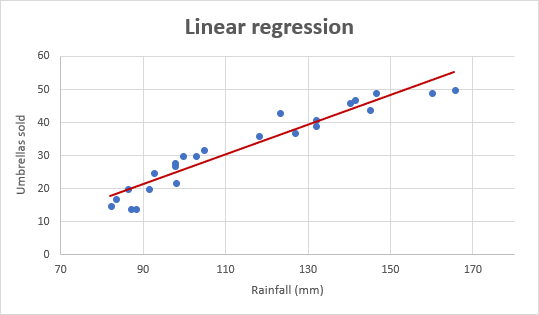
Linear regression equation
Mathematically, a linear regression is defined by this equation:
y = bx + a + ε
Where:
- ten is an independent variable.
- y is a dependent variable.
- a is the Y-intercept, which is the expected mean value of y when all x variables are equal to 0. On a regression graph, it's the point where the line crosses the Y axis.
- b is the slope of a regression line, which is the rate of change for y every bit 10 changes.
- ε is the random error term, which is the divergence between the actual value of a dependent variable and its predicted value.
The linear regression equation always has an error term considering, in real life, predictors are never perfectly precise. Yet, some programs, including Excel, do the error term calculation behind the scenes. So, in Excel, y'all do linear regression using the least squares method and seek coefficients a and b such that:
y = bx + a
For our example, the linear regression equation takes the following shape:
Umbrellas sold = b * rainfall + a
At that place be a handful of different ways to discover a and b. The iii chief methods to perform linear regression analysis in Excel are:
- Regression tool included with Analysis ToolPak
- Scatter chart with a trendline
- Linear regression formula
Below you will find the detailed instructions on using each method.
This case shows how to run regression in Excel by using a special tool included with the Analysis ToolPak add-in.
Enable the Analysis ToolPak add-in
Analysis ToolPak is available in all versions of Excel 2022 to 2003 just is not enabled by default. So, you need to turn it on manually. Hither'southward how:
- In your Excel, click File > Options.
- In the Excel Options dialog box, select Add-ins on the left sidebar, make certain Excel Add together-ins is selected in the Manage box, and click Go.
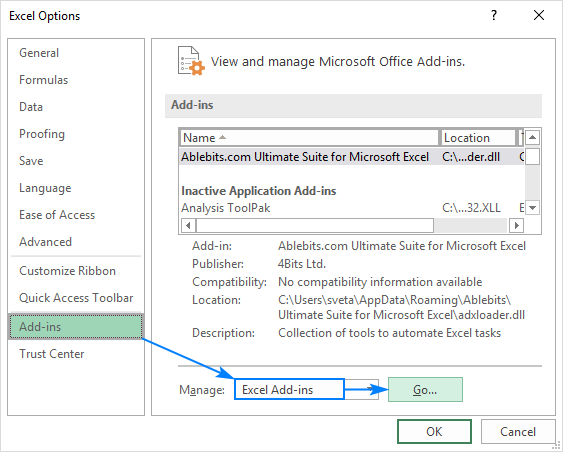
- In the Add-ins dialog box, tick off Assay Toolpak, and click OK:

This will add the Data Analysis tools to the Information tab of your Excel ribbon.
Run regression analysis
In this example, nosotros are going to do a simple linear regression in Excel. What we take is a list of boilerplate monthly rainfall for the last 24 months in column B, which is our independent variable (predictor), and the number of umbrellas sold in column C, which is the dependent variable. Of form, there are many other factors that can affect sales, but for now we focus only on these two variables:
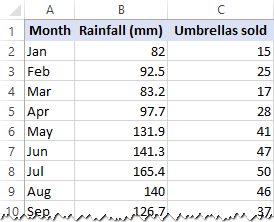
With Assay Toolpak added enabled, carry out these steps to perform regression assay in Excel:
- On the Data tab, in the Assay group, click the Information Analysis button.

- Select Regression and click OK.

- In the Regression dialog box, configure the following settings:
- Select the Input Y Range, which is your dependent variable. In our case, it's umbrella sales (C1:C25).
- Select the Input X Range, i.e. your contained variable. In this example, information technology's the boilerplate monthly rainfall (B1:B25).
If you are building a multiple regression model, select two or more side by side columns with unlike contained variables.
- Check the Labels box if there are headers at the top of your X and Y ranges.
- Choose your preferred Output option, a new worksheet in our example.
- Optionally, select the Residuals checkbox to get the deviation between the predicted and actual values.
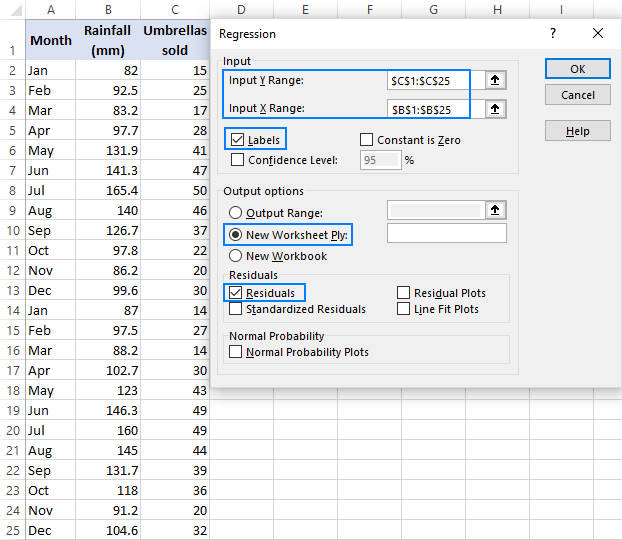
- Click OK and observe the regression analysis output created by Excel.
Interpret regression analysis output
As you accept only seen, running regression in Excel is easy because all calculations are preformed automatically. The interpretation of the results is a bit trickier considering yous demand to know what is behind each number. Below you will find a breakdown of 4 major parts of the regression analysis output.
Regression analysis output: Summary Output
This function tells you lot how well the calculated linear regression equation fits your source data.

Hither's what each slice of information means:
Multiple R. It is the Correlation Coefficient that measures the strength of a linear relationship between two variables. The correlation coefficient tin be any value betwixt -i and 1, and its absolute value indicates the human relationship strength. The larger the absolute value, the stronger the relationship:
- 1 means a stiff positive relationship
- -one ways a strong negative relationship
- 0 ways no relationship at all
R Square. It is the Coefficient of Determination, which is used every bit an indicator of the goodness of fit. It shows how many points fall on the regression line. The R2 value is calculated from the total sum of squares, more than precisely, it is the sum of the squared deviations of the original data from the mean.
In our case, Rii is 0.91 (rounded to 2 digits), which is fairy practiced. It means that 91% of our values fit the regression assay model. In other words, 91% of the dependent variables (y-values) are explained by the contained variables (x-values). More often than not, R Squared of 95% or more is considered a good fit.
Adapted R Foursquare. It is the R square adjusted for the number of independent variable in the model. Y'all will want to use this value instead of R foursquare for multiple regression analysis.
Standard Fault. It is another goodness-of-fit measure that shows the precision of your regression analysis - the smaller the number, the more certain y'all can exist well-nigh your regression equation. While Rii represents the percentage of the dependent variables variance that is explained by the model, Standard Mistake is an absolute measure that shows the average distance that the data points fall from the regression line.
Observations. It is but the number of observations in your model.
Regression analysis output: ANOVA
The second function of the output is Analysis of Variance (ANOVA):

Basically, it splits the sum of squares into individual components that requite information about the levels of variability inside your regression model:
- df is the number of the degrees of freedom associated with the sources of variance.
- SS is the sum of squares. The smaller the Balance SS compared with the Total SS, the better your model fits the data.
- MS is the mean square.
- F is the F statistic, or F-examination for the naught hypothesis. It is used to exam the overall significance of the model.
- Significance F is the P-value of F.
The ANOVA part is rarely used for a simple linear regression analysis in Excel, but you should definitely have a close look at the terminal component. The Significance F value gives an idea of how reliable (statistically pregnant) your results are. If Significance F is less than 0.05 (five%), your model is OK. If information technology is greater than 0.05, you'd probably better cull another contained variable.
Regression analysis output: coefficients
This section provides specific information well-nigh the components of your analysis:

The most useful component in this section is Coefficients. Information technology enables you to build a linear regression equation in Excel:
y = bx + a
For our information ready, where y is the number of umbrellas sold and x is an average monthly rainfall, our linear regression formula goes equally follows:
Y = Rainfall Coefficient * x + Intercept
Equipped with a and b values rounded to iii decimal places, information technology turns into:
Y=0.45*x-xix.074
For example, with the boilerplate monthly rainfall equal to 82 mm, the umbrella sales would be approximately 17.8:
0.45*82-19.074=17.8
In a similar mode, yous tin can find out how many umbrellas are going to be sold with any other monthly rainfall (10 variable) you specify.
Regression assay output: residuals
If you compare the estimated and actual number of sold umbrellas corresponding to the monthly rainfall of 82 mm, yous volition come across that these numbers are slightly different:
- Estimated: 17.8 (calculated above)
- Actual: xv (row ii of the source data)
Why'southward the difference? Because independent variables are never perfect predictors of the dependent variables. And the residuals can help you empathize how far abroad the actual values are from the predicted values:

For the starting time data bespeak (rainfall of 82 mm), the residual is approximately -2.eight. So, we add this number to the predicted value, and get the actual value: 17.8 - 2.8 = 15.
How to make a linear regression graph in Excel
If you need to quickly visualize the human relationship betwixt the two variables, depict a linear regression chart. That's very easy! Here'due south how:
- Select the ii columns with your data, including headers.
- On the Inset tab, in the Chats group, click the Scatter chart icon, and select the Scatter thumbnail (the starting time 1):
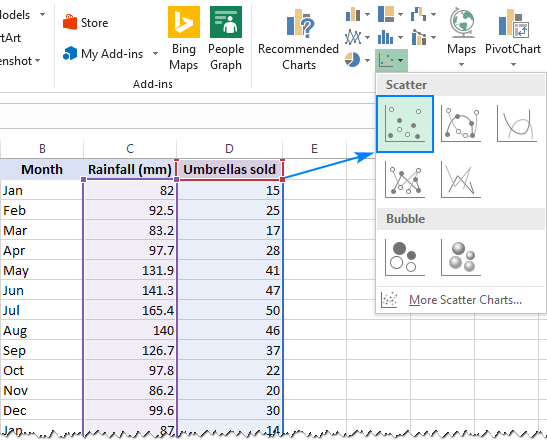
This will insert a scatter plot in your worksheet, which will resemble this i:

- Now, nosotros need to draw the least squares regression line. To have information technology done, right click on any indicate and choose Add Trendline… from the context menu.

- On the right pane, select the Linear trendline shape and, optionally, check Brandish Equation on Nautical chart to become your regression formula:
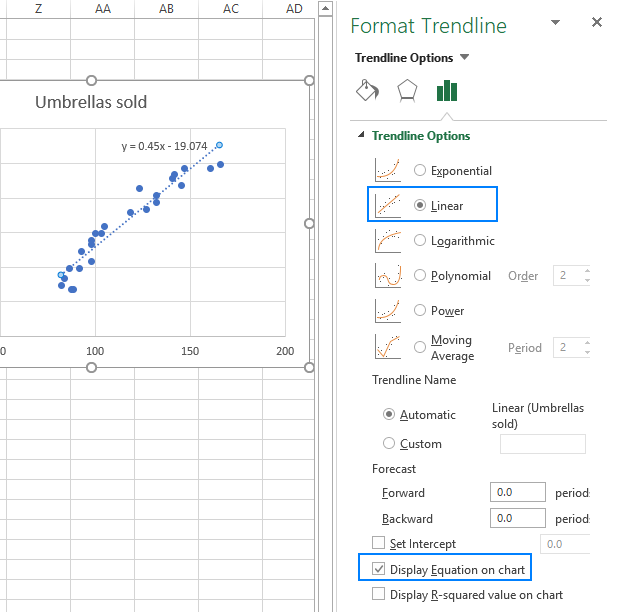
As you may notice, the regression equation Excel has created for us is the aforementioned as the linear regression formula we congenital based on the Coefficients output.
- Switch to the Make full & Line tab and customize the line to your liking. For example, you tin choose a different line color and apply a solid line instead of a dashed line (select Solid line in the Nuance type box):

At this point, your chart already looks like a decent regression graph:

Still, you may want to brand a few more improvements:
- Elevate the equation wherever you lot see fit.
- Add together axes titles (Chart Elements button > Axis Titles).
- If your data points beginning in the middle of the horizontal and/or vertical centrality like in this instance, you may want to get rid of the excessive white infinite. The following tip explains how to practise this: Scale the chart axes to reduce white infinite.
And this is how our improved regression graph looks like:
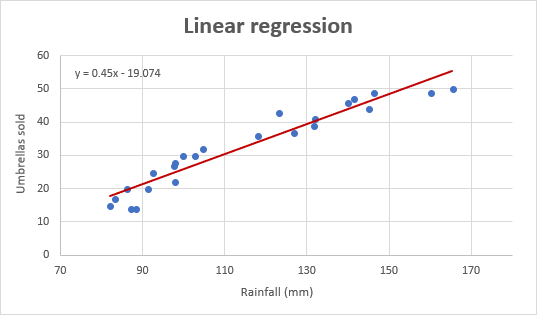
Important note! In the regression graph, the contained variable should always be on the X centrality and the dependent variable on the Y axis. If your graph is plotted in the opposite society, swap the columns in your worksheet, and then draw the nautical chart anew. If y'all are not allowed to rearrange the source data, and so you lot can switch the X and Y axes direct in a chart.
How to practise regression in Excel using formulas
Microsoft Excel has a few statistical functions that can aid yous to exercise linear regression analysis such every bit LINEST, SLOPE, INTERCEPT, and CORREL.
The LINEST role uses the least squares regression method to calculate a straight line that best explains the relationship betwixt your variables and returns an array describing that line. You can observe the detailed explanation of the function's syntax in this tutorial. For now, let's just make a formula for our sample dataset:
=LINEST(C2:C25, B2:B25)
Considering the LINEST function returns an assortment of values, yous must enter it equally an assortment formula. Select ii adjacent cells in the same row, E2:F2 in our case, type the formula, and press Ctrl + Shift + Enter to consummate it.
The formula returns the b coefficient (E1) and the a constant (F1) for the already familiar linear regression equation:
y = bx + a

If you avert using array formulas in your worksheets, you can calculate a and b individually with regular formulas:
Get the Y-intercept (a):
=INTERCEPT(C2:C25, B2:B25)
Become the slope (b):
=Gradient(C2:C25, B2:B25)
Additionally, you tin observe the correlation coefficient (Multiple R in the regression analysis summary output) that indicates how strongly the two variables are related to each other:
=CORREL(B2:B25,C2:C25)
The following screenshot shows all these Excel regression formulas in action:

Tip. If you'd like to get boosted statistics for your regression analysis, use the LINEST part with the due southtats parameter set to True as shown in this case.
That'southward how you practice linear regression in Excel. That said, please proceed in mind that Microsoft Excel is not a statistical program. If you demand to perform regression analysis at the professional level, you may want to use targeted software such as XLSTAT, RegressIt, etc.
Available downloads:
To have a closer look at our linear regression formulas and other techniques discussed in this tutorial, y'all are welcome to download our sample Regression Analysis in Excel workbook.
You may also be interested in
Source: https://www.ablebits.com/office-addins-blog/2018/08/01/linear-regression-analysis-excel/
0 Response to "How to Read Regression Data in Excel"
Post a Comment